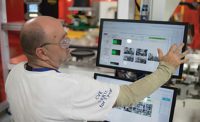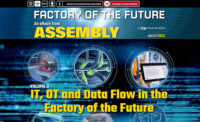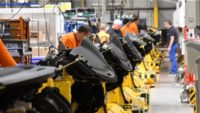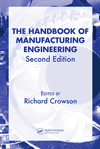History has a strange way of repeating itself. One hundred years ago, the most modern automobile assembly plant in the world was located along the banks of the Grand River in Lansing, MI. Today, the capital of Michigan is once again home to a state-of-the-art car factory.
Ironically, 2002 marks the 100th anniversary of mass production in the auto industry. By developing the process of "progressive assembly," Ransom E. Olds and his employees were able to manufacture 2,500 copies of the curved dash Oldsmobile in 1902. Up until then, the leading manufacturers in the fledgling auto industry were only producing several hundred vehicles a year. For instance, Olds assembled just 425 vehicles in 1901.
The progressive assembly technique pioneered by Olds in his Lansing factory used wooden tables and metal stands mounted on wheeled dollies to speed production and improve workflow. The carts were manually moved from one workstation to the next as parts and components were installed and assembled in sequence to become a completed vehicle.
That was 6 years before General Motors was organized and 11 years before Henry Ford first used a moving assembly line to mass produce his legendary Model T. In fact, Ford visited the Olds Motor Works to get a first-hand look at the innovative assembly process.
That pioneering plant was situated near the site of the GM’s recently opened Lansing Grand River manufacturing complex. But, any other similarities stop there, because the vehicles rolling off the assembly line 100 years ago resembled buggies, while the cars produced at the new plant trace their design inspiration to stealth fighters.
Although automobile technology has changed dramatically in the past century, one thing hasn’t: the pride of the people assembling the vehicles. That heritage is evident throughout the gleaming new facility, especially in the hands and hearts of the assemblers who played a key role in planning the unique layout.
Five months before ground was broken for the plant in January 2000, a group of operators started focusing on issues such as "buildability, maintainability, sustainability of processes and related ergonomic requirements," says Bob Anderson, plant manager. "Lansing Grand River’s commitment to support its people is reflected in the plant layout, which focuses on people needs, such as well-lit workstations and climate-controlled buildings."
Anderson claims that each workstation is designed with the efficiency of the operator in mind. That results in less time wasted while walking to pick up tools and components, less material handling time and less potential for ergonomic injuries. The plant also breaks new ground in physical size, capital investment, supplier systems and labor-management relations.
Factory of the Future
The Lansing Grand River facility is the first all-new factory built by General Motors Corp. (Detroit) in the United States since the Saturn complex cropped up in a field near Spring Hill, TN, in 1986. Unlike other GM plants in the United States, the new flexible facility is capable of building cars and trucks simultaneously. It also is a showcase for the latest lean manufacturing practices gleaned from GM facilities overseas."This is the most significant auto industry plant in the last 25 years," says Dr. David Cole, director of the Center for Automotive Research (CAR, Ann Arbor, MI). "It’s as state of the art as anything you’ll find in the world. With its emphasis on lean and agile manufacturing, Lansing Grand River represents a paradigm change in the industry."
During the past 15 years, GM invested heavily in assembly plants over-seas. Lansing Grand River is based on lessons learned from facilities in Argentina, Brazil, China, Germany, Poland and Thailand. In fact, management and employees from Lansing spent considerable time at GM’s Eisenach, Germany, plant studying lean manufacturing techniques.
"Lansing Grand River embodies everything we’ve learned about lean manufacturing," says Gary Cowger, president of GM North America. "The production system is lean, fast and flexible in order to respond to an ever-changing market."
According to Cowger, Lansing Grand River is "a model for our competitive manufacturing strategies." He says the plant is approximately one-half the size and has half the employment of the five plants constructed during GM’s building spree in the 1980s. For instance, the new facility is 1.9 million square feet vs. 3.5 million square feet for the 17-year-old Detroit-Hamtramck plant that assembles the Cadillac DeVille and Seville. That complex employs more than 3,500 workers, while the new Lansing facility will employ less than 1,500 when it is fully operating.
The $560 million plant also cost about half as much as similar-sized manufacturing facilities. For example, DaimlerChrysler’s 2.1 million square foot Toledo North assembly plant, which opened last summer, cost $1.2 billion. Lansing Grand River was built differently than plants used to be, so it could be economically torn down in as few as 15 years. For instance, the steel structure is lighter.
Unlike traditional car plants, which are typically housed under one roof, Lansing Grand River consists of three separate buildings connected by conveyors. The manufacturing complex includes a 644,000-square-foot general assembly building, a 530,000-square-foot body shop, a 616,000-square-foot paint shop and a 94,219-square-foot administration building.
This unique plant configuration allowed architects and engineers to create multiple loading docks on all sides of the plant to facilitate just-in-time parts delivery from off-site suppliers. It also emphasizes the role of assembly, body and paint as discrete and highly focused business units.
"The buildings are shrink-wrapped around the various manufacturing processes," says Cowger. They are "configured for efficient material flow and to provide an optimum layout for operators."
The facility was built on the site of 19 demolished buildings that were among the original Oldsmobile complex. It is surrounded by several GM plants that currently assemble midsized Buick, Oldsmobile and Pontiac sedans.
But, the Lansing Grand River facility is radically different than its next-door neighbors. For instance, the new plant uses a wide variety of advanced manufacturing processes and assembly techniques to speed product flow, improve quality and reduce time to market.
The spotless general assembly building is extremely bright, with extra wide aisles and high ceilings. There are very few forklift trucks, but scores of automated guided vehicles. Operators wear common clothing to foster team unity. Overhead electronic boards monitor the production heartbeat of the facility. Conveyors automatically raise up or drop down to accommodate the ergonomic needs of assemblers. Nothing is stacked more than 5 feet high to maintain a clear line of vision throughout the plant.
The body shop boasts 338 programmable welding robots that apply 2,163 welds per vehicle. It is the first GM facility to use the company’s programmable adaptable assembly system (PAAS) in full production. The time-saving system is programmed to adjust to different body styles, such as cars, trucks and sport utility vehicles (SUVs), from job to job on the same line.
More than 50 small PAAS robotseach approximately the size of a basketballserve as locating devices to position tools and clamp parts in exactly the right place for different-sized bodies. They replace a traditional system that required cumbersome tooling stations that could index back and forth for different models. To ensure dimensional integrity, every body-in-white is measured at more than 100 points by laser, ultrasound and machine vision.
Lansing Grand River is the first GM plant to locate all paint production processes on a single floor. In traditional paint shops, operators are spread over four floors. Instead of using an elevator system that potentially draws dust because of turbulence, the new plant uses a slow-moving conveyor that rises on an incline to take a car body to the paint oven.
Unique Layout
The general assembly building features a T-shaped layout that helps reduce material handling and improve modular assembly techniques. Its long, narrow legs enable delivery trucks to drop off parts at outside doors next to the place on the assembly line where the parts are needed. Automated material handling systems bring parts directly to the point of use, eliminating the need for forklifts, which reduces congestion and the potential for accidents.In traditional, box-shaped assembly plants, all parts come in one end of the building. Then, they are transported to various spots along the assembly line by forklift.
"In the past, we would listen to architects and build a rectangle or a cube," says Bob Anderson, a 35-year GM veteran. "Then, we’d figure out which corner would be the receiving dock and which corner would be the shipping dock."
Anderson says original plans called for an X-shaped facility in Lansing, similar to the Eisenach plant. However, because the complex is sandwiched between the Grand River and a major interstate highway, architects settled on the T shape.
The assembly line runs along the inside of the T, with every conveyor exposed to the outside wall for optimal material flow. "There is no back and forth snaking of conveyors like you find in traditional auto plants," says Anderson.
The longest portion of the T is devoted to the trim line. As vehicles move along a skillet conveyor, operators install wiring harnesses, seat belts, instrument panels, windshield glass, trunks and hoods. The conveyors automatically adjust the height of the car to a comfortable level for the operator.
The upper right corner of the T is devoted to chassis assembly. Chassis arrive sequentially at the factory with powertrains already installed. Each chassis is placed on an automated guided vehicle that arrives at the assembly line just as the correct body is delivered overhead via a power-and-free conveyor. After operators install and fasten bolts to marry the two components, the vehicle continues down the line as bumpers, headlights, seats, doors, tires and other components are attached.
The upper left corner of the T is devoted to test and inspection. After each vehicle is filled with gas, oil and other fluids, it is driven off the assembly line and put through a rigorous quality confirmation process. For example, a 100-yard indoor test track checks each vehicle for squeaks and rattles. A supply action center addresses any problems with specific parts.
There are 58 loading docks that handle up to 350 trucks a day from nearby suppliers that assemble and sequence modules, such as Denso Corp., Lear Corp., Tower Automotive Inc. and Visteon Corp. The numerous supply bays allow suppliers to deliver parts continually.
"Waste is eliminated by line-side delivery of parts and through subassemblies, either built on feeder lines in the plant or brought in by suppliers," says Anderson. "This direct-to-the-line delivery system eliminates expensive build up of inventories as well as multiple handling of materials.
"Sequencing allows the operator to go to one single point to get a component," explains Anderson. "That eliminates a lot of wasted effort. Each step away from the line is time added to completing a job."
Eight different components are automatically unloaded and conveyed line-side. For example, seats arrive in special trucks that have two levels of roller racks. The seats are automatically unloaded onto battery-powered automated guided carts that follow a tape on the plant floor. They are transported in build sequence directly to operators. All sequencing is done by Lear, which supplies the seats. Empty racks are automatically returned to the shipping dock and loaded onto an outgoing truck.
Other parts are received on dollies that are pulled with tuggers instead of fork lifts. Operators order parts to the assembly line. When an operator signals that a component will be needed, a computerized system alerts a tugger driver and provides the optimum route on a screen.
Anderson says the T-shaped plant layout also improves visual control, another key component of lean manufacturing. Supervisors can observe the entire production process from a central vantage point.
Fast and Flexible
According to Gary Cowger, vehicle development Arial have decreased from 60 months to less than 18 months during the past 10 years. That means assembly plants must be capable of producing new products faster than ever before.Lansing Grand River is designed to allow GM to respond quickly to changes in customer demand and adjust products according to market trends. The flexible facility is capable of assembling five different vehicles at a time.
Traditional auto plants use fixed tooling that is designed to produce only two or three models of a similar design of either cars or trucks. "That leaves manufacturers vulnerable to shifts in consumer demand," says CAR’s Cole. "When you start to run at less than maximum capacity, you start to hurt real bad."
Cole says automakers don’t want to be stuck with a plant tooled for vehicles that aren’t selling well. He says it’s very important to be flexible in today’s economy. For instance, if demand for SUVs suddenly dries up and consumers crave subcompact sports cars instead, an automaker and its suppliers must be able to react.
Flexible manufacturing uses robots, conveyors and other equipment that can be reprogrammed to build vehicles with different designs, such as a four-door sedan, a two-seat sportscar, a pickup and an SUV. It allows automakers to change the mix of products and produce a greater variety of vehicles on the same assembly line.
"Lansing Grand River has the ability to easily absorb other vehicles into the plant," says Cole. "That gives GM the ability to run the plant all the time. They can use a variety of products to juggle different things, depending on the market. And production can expand with little impact on existing operations."
Flexible manufacturing allows operators to produce vehicles destined for both domestic and overseas consumption on the same assembly line. For instance, Lansing Grand River assembles right-hand drive models for customers in Australia, Japan and the British Isles side by side with left-hand drive models. Other components, such as lighting systems, are modified to meet unique European standards.
Later this year, the plant will begin assembling the new Cadillac SRX. The SRX is a "reconfigurable crossover vehicle"a cross between a luxury sedan and a sport utility vehicleexpected to hit the market during the first half of 2003.
Crossovers are touted by auto designers as lifestyle vehicles that resemble station wagons and SUVs. The vehicles are projected to be very popular, but given fickle consumer tastes, that could change overnight.
Like the CTS, the SRX is based on the rear-drive Sigma architecture. Rear drive is the predominant system used by luxury carmakers because it tends to give cars better handling than front-wheel drive.
Cadillac plans to unveil four other all-new products during the next 15 months. "By 2004, Cadillac will be selling five to six models, variants and powertrain applications that we did not have in 2001," says Mark LaNeve, general manager of GM’s Cadillac division. In addition to producing several different Cadillac models, the Lansing Grand River plant will eventually assemble vehicles for Saab, another GM division.
Operators and management have set an ambitious production target of 17 hours per vehicle for the plantone-third less than the industry average of 26.4 hours per car. According to Ron Harbour, president of Harbour and Associates Inc. (Troy, MI), GM averages 26.75 hours per vehicle companywide. Only its Oshawa, ON, plant, which assembles the Chevy Impala, Monte Carlo and Silverado, currently approaches the 17-hour figure.
By comparison, Nissan Motor Manufacturing Corp. U.S.A. (Smyrna, TN) topped the 2001 Harbour Report with an average of 16.33 hours of labor to make its Altima, Frontier and Xterra vehicles. The Ford Motor Co. (Dearborn, MI) plant in Atlanta that assembles the Sable and Taurus ranked second with a score of 16.93 hours.
To hit that 17-hour goal, the new GM plant must be flexible and efficient, with an emphasis on speed and quality. "The way the plant is set up, they can get there," says Harbour. "Just-in-time delivery, sequencing and other flexible manufacturing attributes will make it easy to adjust volume to meet demand. And the UAW leadership in Lansing is one of the best locals in the entire auto industry."
Operator Influence
The organization, structure, layout and production process at Lansing Grand River is designed around providing support for operators. "The organization here is an upside-down pyramid," says Anderson. "The operator is on top. The operators who build the vehicles are the most important people in the manufacturing system."The plant will eventually build 130,000 vehicles annually with two shifts employing less than 1,500 people, which is significantly less than traditional auto plants. The smaller workforce is a tradeoff for a bigger voice in the production process.
Indeed, operators played a key role in establishing assembly processes and procedures. Engineers asked hourly workers for help in designing workstations, placing equipment, planning workflow, scheduling material flow and setting work procedures.
According to Cowger, the work agreement between GM and the UAW allows for advanced manufacturing techniques and competitive work practices. "A key role of the agreement enables us to establish a team structure that plays an essential role in managing safety, quality and cost," says Cowger.
Most employees previously worked at the company’s other assembly plants in Lansing. In fact, the typical operator has been employed with GM for at least 24 years. Instead of using the traditional foreman-line worker arrangement, Lansing Grand River operators were cast into teams, with team leaders and group supervisors.
Operators are trained on a variety of assembly tasks, and teams are in charge of their area. "The role of supervisor is more of a coach or teacher, and leaders receive intensive training in both lean manufacturing and people skills," says Anderson.
Operators are empowered to continuously suggest quality and process improvement changes. According to Anderson, the goal of Lansing Grand River assemblers is "built in quality." That refers to the expectation that quality is achieved in each assembly process, which ensures that defects are not passed on down the line.
Anderson says efforts to perform assembly tasks correctly in station improve quality by cutting down on defects and reducing repair work at the end of the line. Quality checks are performed at 18 online quality verification stations as well as through off-line processes. In total, more than 1,000 checks are performed on every vehicle.
Andon boards hang from the ceiling throughout the plant. The scoreboard-like electronic displays serve as a visual control to help operators quickly and accurately gauge production status at a glance. Progress indicators and problem indicators inform everyone in the plant whether production is ahead, behind or on schedule.
The boards give every operator and supervisor constant feedback on how the plant is operating compared with the day’s planned production. They contain vital production data, such as actual vs. scheduled production numbers, downtime and quality trends.
If a problem occurs on the assembly line, an operator can set off an alarm that lights up on the andon board and immediately notifies the entire plant. Traditionally, the operator would have to leave his workstation to track down a foreman.
Another break from tradition is reflected in the plant dress code. In most auto plants, workers are decked out in an endless variety of T-shirts, jerseys and sweatshirts. But, all Lansing Grand River operators and supervisors are required to wear "a suite of white, black and khaki clothing with common colors that reflect the Cadillac image." The uniform look is intended to promote team unity. Employees have several styles to choose from, such as short- and long-sleeved shirts. That dapper fashion statement would probably be the only thing that Ransom E. Olds would recognize if he suddenly stepped out of the past and into the future of automobile manufacturing.






